Subscribe now to get notified about IU Jharkhand journal updates!
State And Status Of Self Help Groups (SHGS) In Maharashtra : A Study On Self Help Groups In Wardha District
Abstract :
These are the informal groups formed by women for addressing their routine problems of socio-economic in nature. These groups function with a common and general objective of cooperation and mutual trust and support. Even though the initiation of the Self Help Groups could be seen since 1975 the NABARD formally started this concept in 1986-87. The main reason behind the formation of SHGs is to make available the institutional credit facility to the needy and poor women of the SHGs. During the period of 1991-92 NABARD started promoting self-help groups on a large scale. Reserve Bank of India during the year 1992-93 allowed SHGs to open saving accounts in banks. This has become a big boon on the part of the SHG movement in India.
Keywords :
Self Help Groups (SHGs), NABARD, India, Maharashtra, Wardha District
I. Introduction
These are the informal groups formed by women for addressing their routine problems of socio-economic in nature. These groups function with a common and general objective of cooperation and mutual trust and support. Even though the initiation of the Self Help Groups could be seen since 1975 the NABARD formally started this concept in 1986-87. The main reason behind the formation of SHGs is to make available the institutional credit facility to the needy and poor women of the SHGs. During the period of 1991-92 NABARD started promoting self-help groups on a large scale. Reserve Bank of India during the year 1992-93 allowed SHGs to open saving accounts in banks. This has become a big boon on the part of the SHG movement in India.
II. Review of Literature:
The initiation of Self Help Groups in India can be found through the formation of SEWA (Self-Employed Women’s Association) during the year 1972. During the arena of 1992-93 lot of efforts have been played by the NABARD and RBI for the effective launch of SHGs in India. This has begun by way of allowing the SHGs to open and operate the Savings Bank Accounts in the name of their respective groups. During the year 1999 the Government of India with an intention of promoting self employment has initiated the Scheme Swarn Jayanti Gram Swarozgar Yojana through providing better skills and abilities among the members of the SHGs. Ultimately in 2011 the evolution of NRLM (National Rural Livelihoods Mission) took place to include the scope of the SHGs under it for effective promotion as well as development of the SHGs.
III. Stages of Evolution of SHGs in India: (Process)

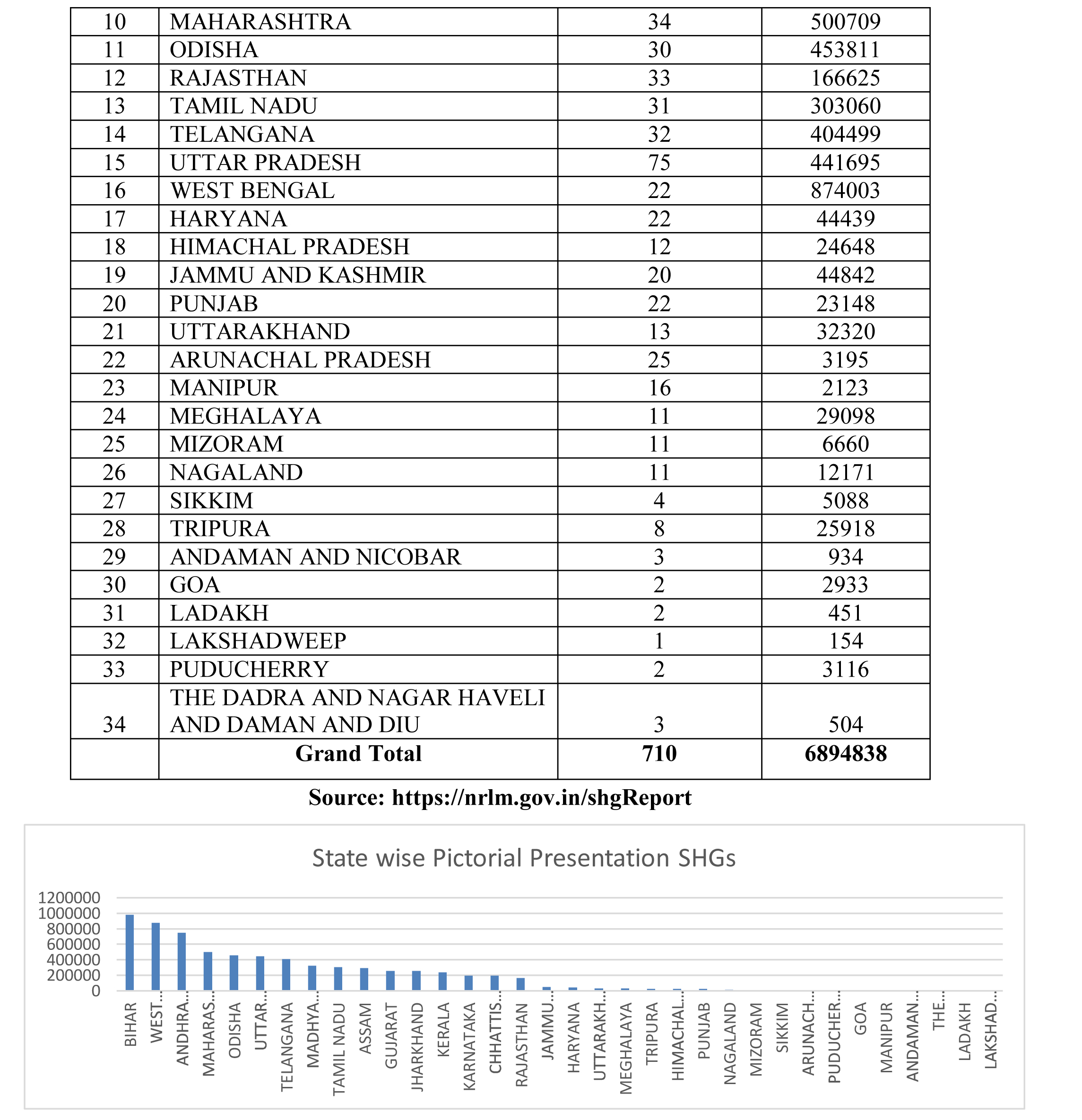
The Self-help promoting agencies include NGOs, Government, Commercial banks, Microfinance institutions, SHG Federations and SHG leaders/Entrepreneurs.
a. Functions of Self Help Groups
1. They try to build the functional capacity of poor and marginalized sections of society in the domain of employment and income-generating activities.
2. Those people who face severe difficulty in getting loans from bank will be rescued with offering of collateral-free loans.
3. Resolution of conflicting situation through dialogue between the parties and mediation.
4. Act as an important source of Micro Finance Service support to the Poor and Needy people of the society.
5. Rural Formal Banking go through is done through the SHGs.
6. Savings habit generation among the poor and down trodden sections and weaker sections of the society.
b. Need for Self Help Groups
It can be observed from the Indian economic scenario that the main reasons for the rural poverty is the lack of access or limited access to credit and financial services. According to the Rangarajan Committee Report the indicated main four major causes are Inability to give collateral security, Weak credit absorption capacity, The insufficient reach of institutions and Weak community network etc.
The SHGs here play a major role to solve the above specified four reasons by way of their functioning. They act as collateral security providers to the poor and weaker sections of people within the groups, nullifying the possibility of weak credit absorption capacity of individuals, enlarge the scope of reaching the trading and economic institutions, and finally facilitate the effective networking and connectivity with the outer world.
c. Advantages of Self Help Groups
1. SHGs support the financial institutions to lend credit to the poor and weaker sections of the society.
2. SHGs act as a voice to those poor and weaker sections of the society.
3. SHGs are an important gateway for organizing several programmes of the Government to eradicate many social ills such as dowry, alcoholism, early marriage, etc.
4. SHGs provide women empowerment and support the nation in carrying out the gender equality.
5. SHGs act as pressure generating forces to make governments govern socially responsible in general and to the rural economy in particular.
6. SHGs help control corruption through social audits.
7. SHGs help people earn their livelihood through vocational training,
8. SHGs encourage savings habit generation among the poor and down trodden sections and weaker sections of the society.
IV. Research Methodology of the Study
The present study is based on the secondary data sources available on the websites of State and Central Governments as well as the research articles and news articles on the Self Help Groups. The data and information obtained have been processed to find out the present state and status of the Self Help Groups in India as well as in the State of Maharashtra with particular emphasis on Wardha District of Maharashtra State.
a. Objectives of the Study
The following are the objectives of the study. They are:
1. To acquire the context and concepts of Self Help Groups in India
2. To find out the state and status of the Self Help Groups in India in Maharashtra and in particular Wardha District of Maharashtra State.
3. To verify the role of Self Help Groups in the development of Wardha District.
b. Hypotheses of the Study
This study has been configured on the following Hypotheses statements. They are:
1. There is significant need of Self Help Groups in India for the economic development of India.
2. There is a significant scope for the further development of Self Help Groups in Maharashtra State and Wardha District.
c. Limitations of the Study
1. The present study is confined to the Wardha District only.
2. The data sources referred are secondary only hence there is a scope of marginal error.
3. The data and information are variable from time to time and may not be updated to the present times.
V. Data analysis and Interpretation: The present study has been conducted from the statistical data and information obtained through the websites of the Central and State Governments. To find out the state of the existence of the Self Help Groups as per the data are described statistically as below:
It can be observed from the Table No.1 and the subsequent diagram that Bihar consisting highest number of Self Help Groups followed by West Bengal, Andhra Pradesh, Maharashtra, Odisha, Uttar Pradesh, Telangana, Madhya Pradesh etc. It shows that the Self Help Groups are highly located in Bihar, West Bengal, Andhra Pradesh, Maharashtra, Odisha, Uttar Pradesh, Telangana, and Madhya Pradesh.
As the present study is confined to Maharashtra State in general and Wardha District in particular the district wise Self Help Groups of entire Maharashtra the data and information of the Maharashtra State district wise is as below. As per the below mentioned Table No.2 it can be observed that there is a minor change in the number of SHGs in comparison to the above Table No.1. This is because of frequent upgradation of Data and information in the Portal. Apart from that it can also be observed that majority of the districts in Maharashtra State are having more than 10,000 Self Help Groups in existence. Among these the districts like Yavatmal, Solapur and Jalgaon have crossed 20,000 SHGs and followed by Amaravati, Beed, Buldhana, Nashik, and Palghar Districts have crossed 19,000 SHGs and the districts like Chandrapur, Gadchiroli, Gondia, Jalna, Latur, Nandurbar, and Ratnagiri have crossed above 15,000 SHGs. Hence it could be stated that the SHGs existence and their status is good and continued in the state of Maharashtra.
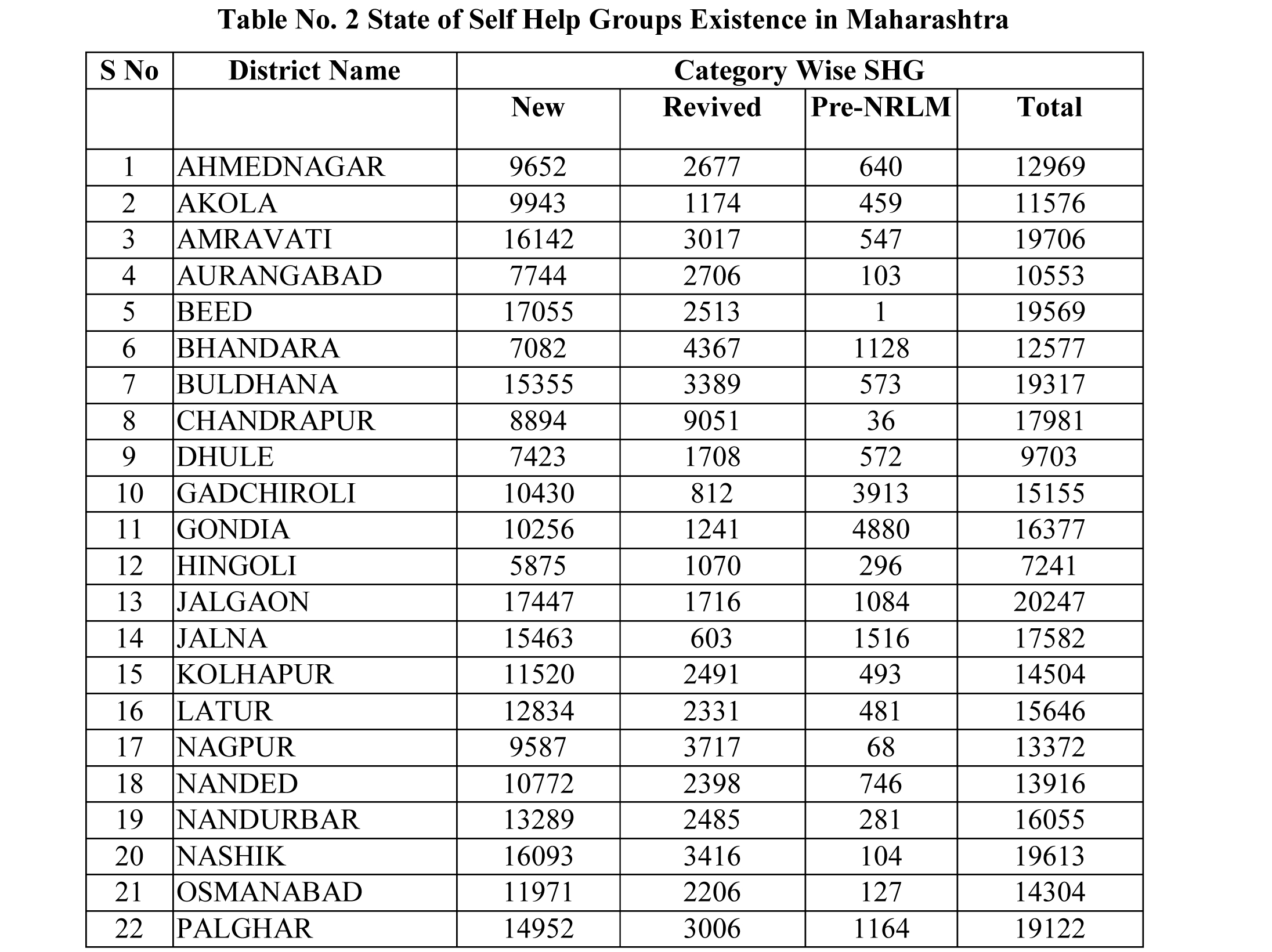
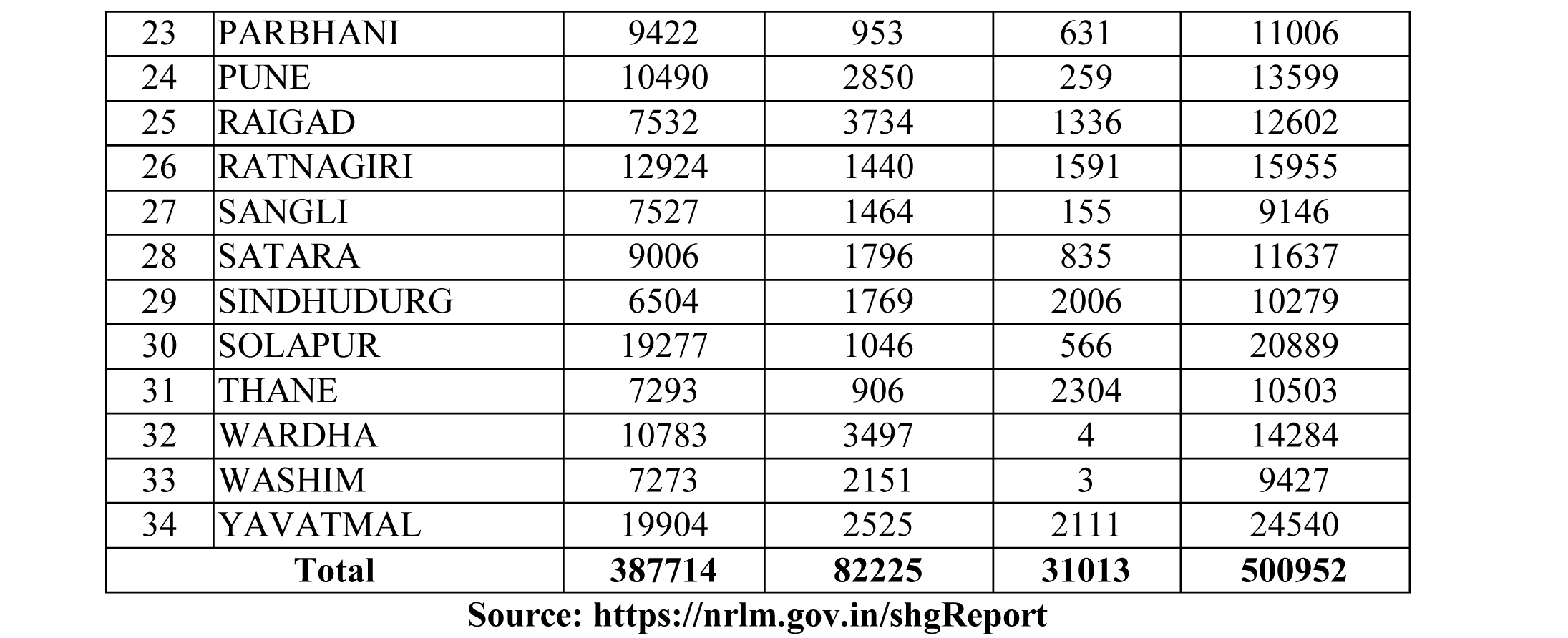 In the case of the Self Help Groups of Wardha District is concerned the following Table No. 3 as describes that Wardha Block is containing majority of the SHGs (2782) followed by Samudrapur, Hinghanghat, Arvi, Deoli, and Seloo Blocks. A very few blocks like Ashti and Karanja are lagging behind to reach a great mark as far as the quantity of the SHGs existence is concerned.
In the case of the Self Help Groups of Wardha District is concerned the following Table No. 3 as describes that Wardha Block is containing majority of the SHGs (2782) followed by Samudrapur, Hinghanghat, Arvi, Deoli, and Seloo Blocks. A very few blocks like Ashti and Karanja are lagging behind to reach a great mark as far as the quantity of the SHGs existence is concerned.
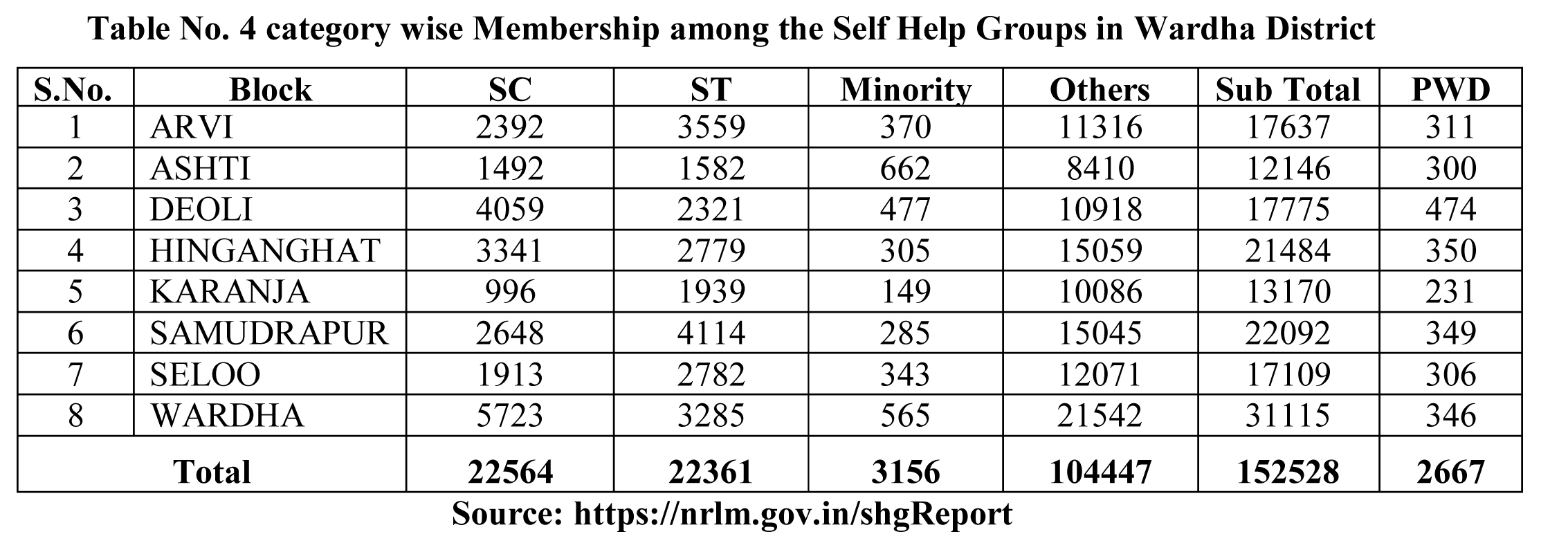
Source: https://nrlm.gov.in/shgReport.
In the case of a clinical observation of the category wise membership dispersion of the Self Help Groups among the backward classes in the Wardha District is concerned as per the Table No. 4 it could be observed that out of the total of 152528 members existing in the 14284 Self Help Groups in Wardha District at present the Scheduled Caste members are 14.79% followed by the Scheduled Tribe members about 14.67%, others are 68.48% and the remaining are Minority group members. Here it can be observed that the Schedule Caste, Scheduled Tribe and Minority Members are very much few in comparison to the other members and there is an urgent need for focus to increase the membership of those groups. In the case of Scheduled Castes membered SHGs are concerned Wardha, Deoli and Hinghanghat are the toppers followed by Samudrapur, Arvi, and Seloo Blocks while Ashti and Karanja are very few. At the same time in the case of the Scheduled Tribes Membered SHGs are concerned Samudrapur and Arvi blocks are the toppers followed by Wardha, Hinghanghat, Deoli, Seloo, and Karanja and the remaining are lagging behind in this context.
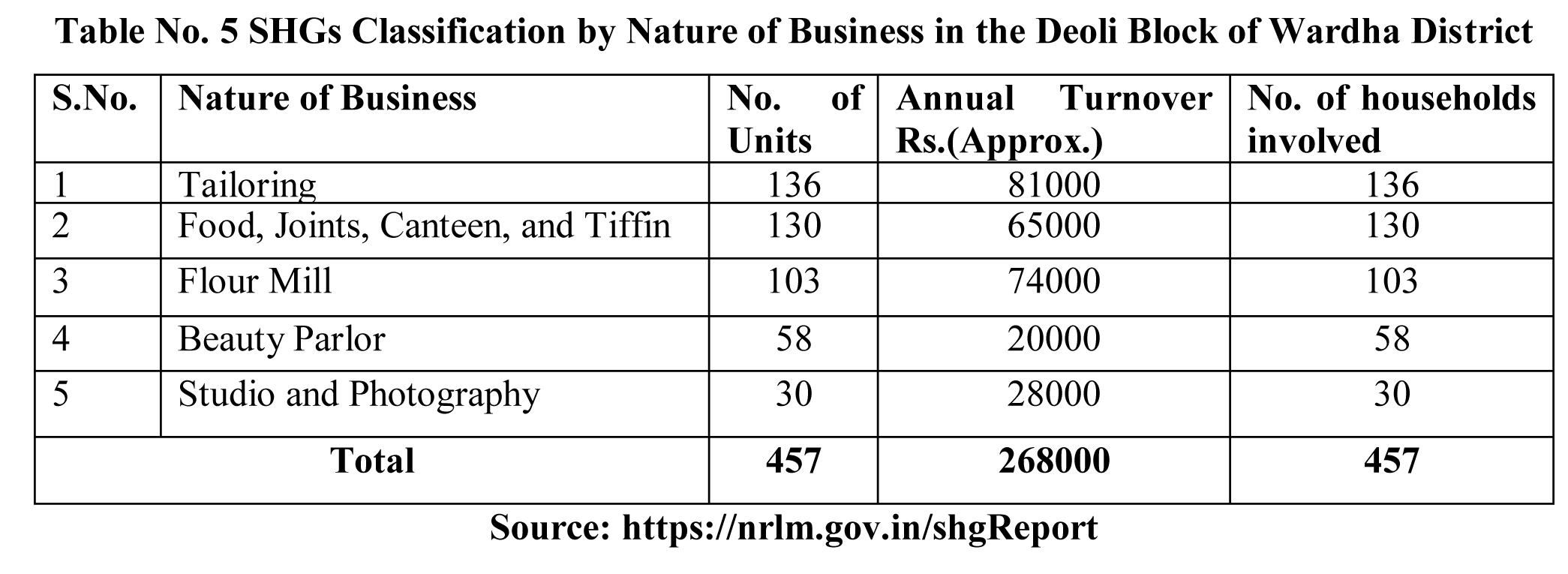
Now it is the turn of sample study of the Block Deoli regarding the Self Help Groups existence is concerned. It can be found out from the Table No. 5 that describes the type of the SHG based upon the nature of its business and other details of the SHG. As per this table it can be concluded that majority of the Self Help Groups in the Deoli Block are limited to the extent of place demanded entities and particularly with a very low income. As far the Per Capita income is concerned it will be much more less.
Findings of the Study:
The different findings yielded out of the present study are as follows:
1. Maharashtra state is at present in 04th Position in the entire country as far the existence of the SHGs are concerned. There is a huge requirement of enhancing the quantity of the SHGs in the State of Maharashtra.
2. In the case of Wardha District in Maharashtra there are very low SHGs in comparison to several other districts of Maharashtra. There is an immense need of increasing the SHGs in this Wardha District in future and immediately.
3. As far as the different blocks in the Wardha District are concerned still there is a lot to be done to enhance the formation of SHGs in the district.
4. There is an urgent need to enhance the Units and Membership in the SHGs in general and in particular regarding the Scheduled Castes, Scheduled Tribes and Minorities in the Wardha District.
5. It can also be find out that there are a very few categories of business entities by nature of business is at present in existence in the Wardha District. There is an urgent need to focus on the diversification of the business establishment through SHGs in to various types and natures of businesses also.
6. Until and unless the SHGs developed in increased number in the Wardha District there is not at all possibility of rural employment generation particularly among the women and the elevation of the standard of living is very much difficult.
VI. Suggestions
The different suggestions for the enhancement of the state and status of the Self Help Groups in the Wardha District in particular are as follows:
1. There is an urgent need to enhance the quantity of the Self Help Groups in Wardha District.
2. It is also important to elevate the quantity of the Self Help Groups pertaining to the Scheduled Castes, Scheduled Tribes and Minorities in the Wardha District.
3. There is a vital point to be identified that the varieties of the business units in different categories of nature of businesses need to be issued and developed among the Self Help Groups in the Wardha District.
4. The suggestion for the enhancement of the capital requirements to the Self Help Groups in Wardha district is to be considered by the officials.
5. The livelihood generation is highly advised through the formation of Self Help Groups in the Wardha District.
6. More planning to extend the Self Help Groups across the Wardha District is also essential to improve the overall coverage of Self Help Groups in the Wardha District.
Conclusion:
Being Vidharbha an under developed region of Maharashtra State in all dimensions the socio-economic profile change is based upon the creation of different avenues for employment generation and livelihood creation. SHGs play a vital role in this context. So also there is an urgent need to enhance the quantity of the Self Help Groups in the entire Maharashtra State and in particular the districts of the Vidharbha Region. In the case of the Wardha District there is also a need to magnify the importance and the role of Self Help Groups in the Rural and Women employment generation and empowerment aspects.
References
1. http://ncwapps.nic.in/pdfReports/SHG-Maharashtra.pdf
2. https://nrlm.gov.in/shgReport
3. Different news items in News Papers of Maharashtra.
4. Project works of different Post Graduate Students of Commerce and Management.
